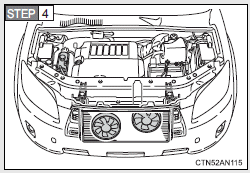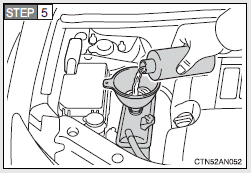 Toyota RAV4: If your vehicle overheats
Toyota RAV4: If your vehicle overheats
If your engine overheats:
1 Stop the vehicle in a safe place and turn off the air conditioning system.
2 Check to see if steam is coming out from under the hood.
If you see steam:
Stop the engine. Carefully lift the hood after the steam subsides
and then restart the engine.
If you do not see steam:
Leave the engine running and carefully lift the hood.
3 Check to see if the cooling fans are operating.
If the fans are operating:
Wait until the temperature of the engine (shown on the
instrument cluster) begins to fall and then stop the engine.
If the fans are not operating:
Stop the engine and call your Toyota dealer.

After the engine has cooled down sufficiently, check the engine coolant level and inspect the radiator core (radiator) for any leaks. If the engine compartment cover needs to be removed.

Add engine coolant if necessary. Water can be used in an emergency if engine coolant is unavailable.
Have the vehicle checked at the nearest Toyota dealer as soon as possible.
■Overheating
If you observe the following, your vehicle may be overheating.
●The engine coolant temperature gauge enters the red zone or a loss of
power is experienced.
●Steam is coming from under the hood.
CAUTION
■To prevent an accident or injury when inspecting under the hood of
your vehicle
●If steam is seen coming from under the hood, do not open the hood until
the steam has subsided. The engine compartment may be very hot, causing
serious injury such as burns.
●Keep hands and clothing away from the fan and other belts while the
engine is running.
●Do not loosen the coolant reservoir cap while the engine and radiator are
hot.
Serious injury, such as burns, may result from hot coolant and steam
released under pressure.
NOTICE
■When adding engine coolant
Wait until the engine has cooled down before adding engine coolant.
When adding coolant, do so slowly. Adding cool coolant to a hot engine too
quickly can cause damage to the engine.
 If the battery is discharged
If the battery is discharged
The following procedures may be used to start the engine if the vehicle's
battery is discharged.
You can call your Toyota dealer or qualified repair shop.
If you have a set of jumper (or booster) c ...
 If the vehicle becomes stuck
If the vehicle becomes stuck
Carry out the following procedures if the tires spin or the vehicle
becomes stuck in mud, dirt, or snow.
1 Stop the engine. Set the parking brake and put the shift
lever in P.
2 Remove the mud, sn ...
See also:
Ejecting all discs from the player (all disc ejection mode)
1. If you continue to press the
button, the player will produce beep sound
and will enter the all disc ejection mode. At
this time, the disc number indicator and
“ALL EJECT” indicator wil ...
Warranties for your Hyundai vehicle
Please consult your Owner's Handbook &
Warranty Information booklet for your
vehicle's specific warranty coverage. ...
Tyre pressure monitoring (TPM) system
The TPM system provides a low
pressure warning and does not
re-inflate your tyres. Tyre pressures
should be checked regularly using an
accurate pressure gauge when cold.
The TPM system can NOT r ...
